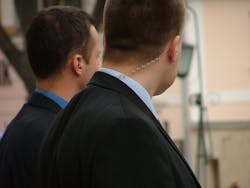The shooting of House Majority Whip Steve Scalise (R-La.) along with several others at a Republican congressional baseball practice in Virginia earlier this week has raised questions about what can be done to better protect lawmakers at all levels of government. The rampage by the gunman, identified as 66-year-old James T. Hodgkinson, of Belleville, Ill., harkened back memories of the attempted assassination of U.S. Rep. Gabrielle Giffords of Arizona at a political event in Tucson in January 2011, which resulted in the shooting deaths of six people and also left Giffords severely wounded.
Had it not been for the heroic actions of the U.S. Capitol Police officers assigned to Scalise’s security detail, who returned fire and took down Hodgkinson, the outcome of Wednesday’s shooting would have been much, much worse. Two of those officers were also wounded during the shootout.
Former Secret Service Agent W. Dennis Maez, who worked on Jesse Jackson's campaign security detail in 1984 and later served as a supervisor on George W. Bush's campaign security team, believes this most recent shooting will likely change security protocols for large gatherings of legislators moving forward.
“Anytime there is a gathering of elected officials, whether it’s Congress, state governors or things of that nature, you’re going to see a fairly significant increase in protection for them,” says Maez, who now serves as president and owner of Maez Security Consultants. “These incidents are not as few and far between as they used to be and the mood of the country is very volatile and because of that, it’s going to be incumbent upon those who protect the country’s leaders to step up their game and become a lot more proactive and assign more agents and officers to take care of these individuals.”
Robert Oatman, president of executive protection firm R.L. Oatman & Associates, says that the Giffords shooting was a “game-changer” and that the shooter in that incident, Jared Loughner, has become a case study for those learning about the principles of executive protection. Oatman, who is one of the nation’s leading experts on executive protection and has authored several books on the subject, believes the shooting of Scalise will be yet another transformative event for the industry. However, there is very little that can be done to change some of the challenges inherent with protecting most elected officials.
“I think it is a challenge protecting anybody but people who are more visible and want to meet their constituents, attend events and shake hands with potential voters, it’s a challenge. You can ask anybody who comes out of government that works this kind of detail – from Secret Service to State Department to governor’s details and mayor’s details,” Oatman says. “They want space understandably but these (attacks) happen up close and personal and they are over within seconds.
“What’s dynamic about this one is the shooter uses a location where they are playing baseball and so you’re not going to see a protection guy or gal two feet away from their protectee because it wouldn’t fit the scenario and it would look silly. You can see the challenges here. It’s really, really difficult. People want to lead a normal life and politicians want to be seen and not look as if they are in a protective bubble.”
According to Maez, one of the biggest things that determine the level of protection a politician needs to receive is the gathering of intelligence which helps authorities isolate and hone in on specific threats they feel to be credible. “This type of incident will obviously increase security for members of Congress. One of the concerns will be copycats. Will this spur others who thought about doing something just as horrific into actions instead of just thought?” he says. “All of those agencies are working together, sharing intelligence and coordinating events. None of them work in a vacuum.”
Oatman agrees that intelligence is paramount in being able to predict this type of attack. “We have to have robust intelligence to say, ‘hey, this guy is ready to go postal on us,’ he says. “This guy was on a path of destruction and when you go in reverse and start looking at the rest of this story; it’s going to be very telling.”
Much like the aftermath of other active shooter incidents, Maez says authorities will examine what kind of behavior red flags Hodgkinson may have exhibited prior to acting out violently to see how they could have better mitigated against it. According to published reports, Hodgkinson had expressed hate for Republicans and President Donald Trump, in particular, on social media, writing on Facebook in March that: “Trump is a Traitor. Trump Has Destroyed Our Democracy. It’s Time to Destroy Trump & Co.”
“In the great percentage of active shooter incidents, the shooter has made their intentions known to somebody before they do something,” Maez says. “They’ve said something to somebody and, unfortunately, that person has blown them off or not told authorities. How many times, in the aftermath, have we seen where a person had said things to certain people, started stockpiling ammunition or writing threatening emails, or something along those lines?”
While only the highest-ranking members of both parties currently have their own security details, Maez thinks this shooting will ramp up protection for everyone on Capitol Hill. “Even the most freshmen member of Congress is a target and softer targets are easier to get to than obviously the leadership or the president, vice president and people like that,” he adds. “But, I firmly believe that even the most junior member of Congress will start having more security involved with them.”
Given that law enforcement resources are already stretched thin; however, Oatman says there will likely be opportunities for protection professionals in the private sector to play a role in providing enhanced security for lawmakers to some degree. “Law enforcement can’t do it by themselves,” he adds. “At these town hall meetings taking place with both senators and Congress people, there are police officers posted and they are coming from police agencies that are giving up their manpower to protect these events due to the hostility and some of the real nonsense that has taken place at them.”
At any rate, Maez believes it will take a more engaged citizenry to be able to prevent shootings like this in the future. “These types of things are not just a law enforcement problem, it’s a national problem and citizens have to become proactive. The old saying, ‘see something, say something,’ has become a bit cliché but it is really important because law enforcement can’t do it all.”
About the Author:
Joel Griffin is the Editor of SecurityInfoWatch.com and a veteran security journalist. You can reach him at [email protected].


